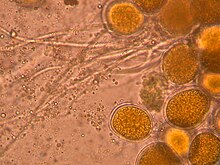Amastigomycota
| Amastigomycota | |
|---|---|

| |
| Endogone, a mucoromycote | |
| Scientific classification | |
| Domain: | Eukaryota |
| Kingdom: | Fungi |
| Clade: | Amastigomycota |
| Subkingdoms and phyla | |
| |
| Synonyms | |
|
Eufungi Cavalier-Smith, 1981 | |
Amastigomycota or Eufungi is a clade of fungi. It includes all fungi without flagella or centrioles, and with unstacked Golgi apparatus cisternae. Members of this clade are Dikarya and the traditional paraphyletic assemblage "Zygomycota",[1][2][3] now divided into several monophyletic phyla.[4]
Classifications[edit]
Cavalier-Smith (1981)[edit]
- Kingdom (or Subkingdom) Eufungi
- Phylum Hemiascomycota
- Phylum Ustomycota
- Phylum Zygomycota
- Phylum Ascomycota
- Phylum Uredomycota
- Phylum Basidiomycota
At the time, the monophyly of Fungi (Eumycota) was not fully certain. Cavalier-Smith considered one scenario where Eufungi could be ancestral or basal to other eukaryotes due to their relatively simple cytology and small genome, though he favoured the hypothesis of fungal monophyly,[2] which is now the consensus.[4]
Phylogenetic tree[edit]
| Zoosporia |
| ||||||||||||||||||||||||||||||
References[edit]
- ^ Sherwood-Pike, Martha (1991-01-01). "Fossils as keys to evolution in fungi". Biosystems. 25 (1–2): 121–129. doi:10.1016/0303-2647(91)90018-G. ISSN 0303-2647. PMID 1854910.
- ^ a b Cavalier-Smith, T. (1981-01-01). "Eukaryote kingdoms: Seven or nine?". Biosystems. 14 (3–4): 461–481. doi:10.1016/0303-2647(81)90050-2. ISSN 0303-2647. PMID 7337818.
- ^ Liu, Yajuan J; Hodson, Matthew C; Hall, Benjamin D (2006-09-29). "Loss of the flagellum happened only once in the fungal lineage: phylogenetic structure of Kingdom Fungi inferred from RNA polymerase II subunit genes". BMC Evolutionary Biology. 6: 74. doi:10.1186/1471-2148-6-74. ISSN 1471-2148. PMC 1599754. PMID 17010206.
- ^ a b Tedersoo, Leho; Sánchez-Ramírez, Santiago; Kõljalg, Urmas; Bahram, Mohammad; Döring, Markus; Schigel, Dmitry; May, Tom; Ryberg, Martin; Abarenkov, Kessy (2018-05-01). "High-level classification of the Fungi and a tool for evolutionary ecological analyses". Fungal Diversity. 90 (1): 135–159. doi:10.1007/s13225-018-0401-0. hdl:10138/238983. ISSN 1878-9129. S2CID 21714270.
